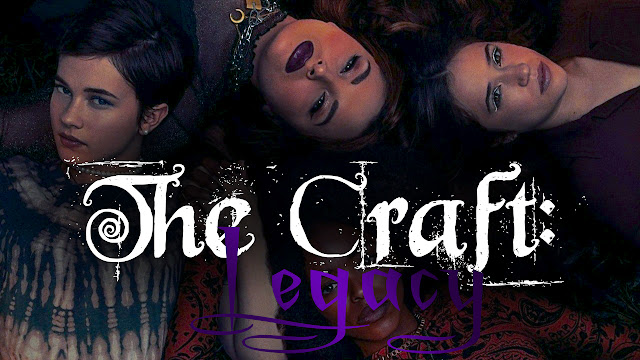There are a few of lessons to be learned from making a sequel 24 years after the original. First is, don't make the same movie again. Second, don't spoil your "big reveal" in the trailer for your movie. Third, make sure you pay attention to what the original movie is trying to say, and continue with that message, or at the very least have a similar message in the new one. The Craft: Legacy KIND OF does all of these things, and at the same time none of them.
This is your warning. There may be some spoilers in this review. I will try to steer around them as much as possible, but there is no way to avoid them all and still discuss the points of this movie.
So, our first lesson is to not make the same movie again. This movie is, much like we have seen in recent years, a "lega-sequel." Meaning it is kind of a reboot/retelling of the original story, but also a sequel to the original. Which already is working against any movie, the fans of the original will likely be hyper critical, and any potential new audience won't understand the relevance of the story, unless it is done well.
For the first 2 acts of this movie, it basically feels like Zoe Lister-Jones just wanted to make an updated version of the '96 original, to wildly varying degrees of success. The main beats of the original story are there, with a modern twist. New girl in town teams up with local outcast types and witchcraft ensues. Pretty simple. The "modernized" dialogue seems awkward, and very much like what a thirty-something thinks high school students speak to one another, based on weak pop-culture references. The poor dialogue aside, there were the makings of a passable update there. It was the third act that just threw all the good will out the window. But we will get to that in a moment.
The second lesson is a simple one, and one that many movies are guilty of violating in recent years. Though, this time around the trailer spoiled only one of two big reveals, and did so using footage that didn't actually make it into the final film.
There are two scenes hinted at in the trailer, actually, that never made it into the final edit. The first of which is a scene, presumably, where our young witches are practicing their new found powers. There is a very brief shot of their feet in a circle where one of them is floating toward the center of said circle. This is a call-back to the original movie, and actually would have been interesting to see in the final product. The second is, again presumably, in reference to the parentage of the lead, Lily (played by Cailee Spaeny). The shot is of a picture of Faruzia Balk's character Nancy Downs, from the first film. When the lineage of Lily is brought into question in the movie, and that scene was missing, it didn't take much brain power to connect the dots.
The final lesson is to continue the message of the original, or at least have a similar one. Again, there is a setup here that seems to fall in line with the original movie. The message, as I see it anyway, of the original movie is a combination of "be careful what you wish for," and "sometimes your worst enemy is yourself." While there is some lip service for the first of these, the second seems to be missing entirely.
Instead of playing with the nuance of the internal struggle that everyone goes through in high school, and telling that through a coming of age story of a group of young witches, Lister-Jones decided to make a statement that nails it to this very specific point in time. The former would have given this movie a more timeless feel, similar to the original (agreed that it isn't the MOST timeless movie, but it is a sight more timeless than this one) the latter makes it feel suddenly dated before the run time even comes to an end.
A reasonable pivot from the "worst enemy" would have possibly been a discussion on power. Which seems to be the best of both worlds, a nuanced discussion on an issue that young people all come across, AND been a way to bring light to an issue in these modern times. This seems to be what Lister-Jones was attempting, but only without all that nuance. The power discussion QUICKLY devolves into a tired one note chorus of White Man bad.
Lister-Jones claims to have done "a lot of research into the world of men's rights activists," which should show in the way she wrote the main villain of the movie. But in her presentation of the villain, before he is revealed to be the villain, she seems to show some positive masculinity. At least in the moment before he reveals himself to be a horrible human being, he is helping his son cry, and deal with the death of his friend. The villain turn happens shortly there after, and the next time we see our villain he is in all of his black eyed glory. Before this though, there is NO indication of his possible status of Men's Rights activist.
On the whole, there is the makings of a pretty good movie here. If it hadn't been bogged down by politics it could have serviced a new generation of curious young women. The third act though is just not up to those same standards.
Grade: C-

No comments:
Post a Comment